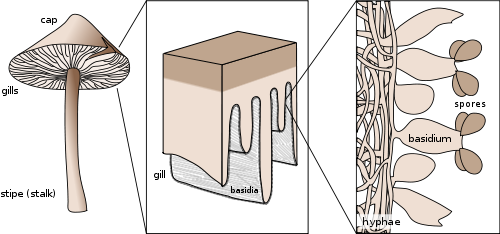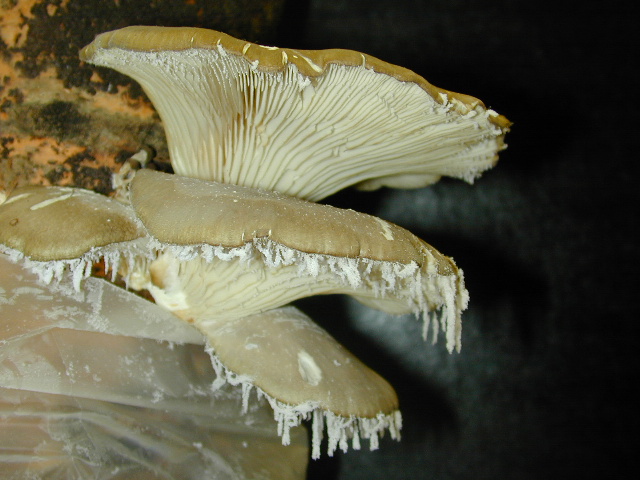Reproduction
Fungi tend to have unique and fairly complex life cycles and Pleurotus ostreatus is no exception. As mentioned on the classification page, Pleurotus is a member of the basidiomycota, meaning that it bears its spores externally on club shaped structures called basidia.

Club shaped basidia glow and release the
reproductive basidiospores in the basidiomycota.
As a typical member of the basidiomycota, sexual reproduction in oyster mushrooms follows a regular pattern marked by a number of major events.
The life cycle of Pleurotus ostreatus
-
The Pearl Oyster Mushroom begins it's life as a haploid spore that's released from the basidium. The likelihood of a spore landing in a suitable spot to thrive is exceptionally low, but Pleurotus ostreatus makes up for it by ejecting millions of spores. To get an idea, watch this video of Pleurotus ostreatus discharging spores at a commercial facility.
-
If the spore beats the odds, it lands in a suitable environment and germinates into a haploid mycelia that grows and feeds until...
-
The haploid mycelia meets another haploid mycelia of a compatible mating type and they undergo plasmogamy, fusion of their cell membranes to create a dikaryotic cell, one with two genetically different haploid nuclei.
Animals and plants have it easy and usually have a way to ensure that eventually sperm meets egg, but fungi have no such luxury. To make up for the slim odds of just stumbling across a male/female, many fungi have adapted to have more "sexes", called mating types. Each mating type can successfully mate with another individual of a different mating type, increasing the odds of being able to mate with any random individual from 1/2 to almost 1 because some fungi have thousands of mating types. Pleurotus ostreatus has four mating types. -
The new dikaryotic cell multiplies and divides to live as a multi-cellular dikaryotic organism. This is the dominant stage of a fungal life cycle and Pleurotus ostreatus will spend a majority of its life in this phase while growing and gathering nutrients.
-
An environmental trigger is set off, signaling the dikaryotic mycelium to generate a mushroom. Here in the Midwest, we can expect Pleurotus ostreatus to bloom in the late summer, around August, but it can be seen at different times depending on the climate. In the south P. ostreatus can bloom as late as December.
-
The mushroom develops dikaryotic basidia that line the surface area of the gills.
-
The nuclei in the basidia finally undergo karyogamy, fusion of the nuclei, and at last form a diploid nucleus that quickly undergoes meiosis.
-
Each diploid nucleus yields four haploid nuclei of different mating types that develop into a basidiospore to repeat the cycle.

Spores hang in clumps from a sporulating Pearl
Oyster Mushroom.
It should be noted that plasmogamy and karyogamy aren't unique to fungi. They both occur in every sexual life cycle when sperm meets egg, but they occur in quick succession. Fungi are unique in that dikaryogamy is a dominant stage in their life cycle.
Click here to continue and learn about the habitat of Pleurotus ostreatus.
